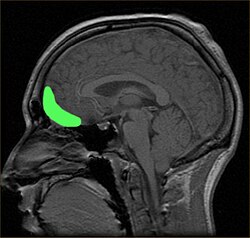| Orbitofrontal cortex | |
|---|---|
 Approximate location of the OFC shown on a sagittal MRI | |
 Orbital surface of left frontal lobe (from below) | |
| Details | |
| Part of | Frontal lobe |
| Identifiers | |
| Latin | cortex orbitofrontalis |
| NeuroNames | 91 |
| NeuroLex ID | birnlex_1049 |
| FMA | 242003 |
| Anatomical terms of neuroanatomy | |
The orbitofrontal cortex (OFC) is a prefrontal cortex region in the frontal lobes of the brain which is involved in the cognitive process of decision-making. In non-human primates it consists of the association cortex areas Brodmann area 11, 12 and 13; in humans it consists of Brodmann area 10, 11 and 47.[1]
The OFC is functionally related to the ventromedial prefrontal cortex.[2] Therefore, the region is distinguished due to the distinct neural connections and the distinct functions it performs.[3] It is defined as the part of the prefrontal cortex that receives projections from the medial dorsal nucleus of the thalamus, and is thought to represent emotion, taste, smell and reward in decision making.[4][5][6][7][8][9][10][11] It gets its name from its position immediately above the orbits in which the eyes are located. Considerable individual variability has been found in the OFC of humans.[12] A related area is found in rodents.[13]
- ^ Kringelbach M. L. (2005). "The orbitofrontal cortex: linking reward to hedonic experience". Nature Reviews Neuroscience. 6 (9): 691–702. doi:10.1038/nrn1747. PMID 16136173. S2CID 205500365.
- ^ Phillips, LH., MacPherson, SE. & Della Sala, S. (2002). 'Age, cognition and emotion: the role of anatomical segregation in the frontal lobes: the role of anatomical segregation in the frontal lobes'. in J Grafman (ed.), Handbook of Neuropsychology: the frontal lobes. Elsevier Science, Amsterdam, pp. 73-98.
- ^ Barbas H, Ghashghaei H, Rempel-Clower N, Xiao D (2002) Anatomic basis of functional specialization in prefrontal cortices in primates. In: Handbook of Neuropsychology (Grafman J, ed), pp 1-27. Amsterdam: Elsevier Science B.V.
- ^ Gottfried, Jay A.; Zald, David H. (December 2005). "On the scent of human olfactory orbitofrontal cortex: Meta-analysis and comparison to non-human primates". Brain Research Reviews. 50 (2): 287–304. doi:10.1016/j.brainresrev.2005.08.004. PMID 16213593.
- ^ Rolls, Edmund T. (June 2004). "The functions of the orbitofrontal cortex". Brain and Cognition. 55 (1): 11–29. doi:10.1016/S0278-2626(03)00277-X. PMID 15134840.
- ^ Kringelbach, Morten L. (September 2005). "The human orbitofrontal cortex: linking reward to hedonic experience". Nature Reviews Neuroscience. 6 (9): 691–702. doi:10.1038/nrn1747. ISSN 1471-003X. PMID 16136173.
- ^ Rushworth, M.F.S.; Behrens, T.E.J.; Rudebeck, P.H.; Walton, M.E. (April 2007). "Contrasting roles for cingulate and orbitofrontal cortex in decisions and social behaviour". Trends in Cognitive Sciences. 11 (4): 168–176. doi:10.1016/j.tics.2007.01.004. PMID 17337237.
- ^ Dixon, Matthew L.; Thiruchselvam, Ravi; Todd, Rebecca; Christoff, Kalina (October 2017). "Emotion and the prefrontal cortex: An integrative review". Psychological Bulletin. 143 (10): 1033–1081. doi:10.1037/bul0000096. ISSN 1939-1455. PMID 28616997.
- ^ Kringelbach, Morten L.; Rolls, Edmund T. (April 2004). "The functional neuroanatomy of the human orbitofrontal cortex: evidence from neuroimaging and neuropsychology". Progress in Neurobiology. 72 (5): 341–372. doi:10.1016/j.pneurobio.2004.03.006. ISSN 0301-0082. PMID 15157726.
- ^ Damasio, Antonio R. (1994). Descartes' error: emotion, reason, and the human brain. New York: Putnam. ISBN 978-0-399-13894-2.
- ^ Fuster, J.M. The Prefrontal Cortex, (Raven Press, New York, 1997).
- ^ Isamah N, Faison W, Payne ME, MacFall J, Steffens DC, Beyer JL, Krishnan R, Taylor WD (2010). "Variability in Frontotemporal Brain Structure: The Importance of Recruitment of African Americans in Neuroscience Research". PLOS ONE. 5 (10): e13642. Bibcode:2010PLoSO...513642I. doi:10.1371/journal.pone.0013642. PMC 2964318. PMID 21049028.
- ^ Uylings HB, Groenewegen HJ, Kolb B (2003). "Do rats have a prefrontal cortex?". Behav Brain Res. 146 (1–2): 3–17. doi:10.1016/j.bbr.2003.09.028. PMID 14643455. S2CID 32136463.